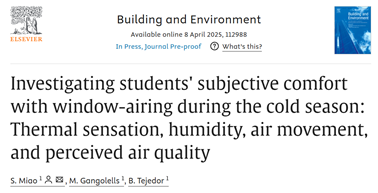The IAQ4EDU project proposes a novel model for determining comfortable indoor temperature setting of the classroom under natural ventilation in the cold season
Apr 11, 2025
The article has been published in the journal Building and Environment
The IAQ4EDU project has proposed a novel model for determining comfortable indoor temperature setting of the classroom under natural ventilation in the cold season. The paper was published in the top indexed journal Building and Environment (JCR-Q1, Impact Factor: 7.1), is entitled "Investigating students' subjective comfort with window-airing during the cold season: Thermal sensation, humidity, air movement, and perceived air quality". The PhD student Sen Miao conducted the research under the supervision of Prof. Marta Gangolells, principal investigator of the IAQ4EDU project, and Prof. Blanca Tejedor.
Opening windows for ventilation in winter could be inevitable for protecting students' health, especially during the flu season. Although existing research have highlighted this may compromise students' thermal comfort, the mechanism between ventilation and students’ comfort is still unknown. Therefore, IAQ4EDU conducted the first experimental investigation specifically targeting this aspect. The results showed that temperature is the decisive factor under forced window ventilation, and air movement has a relatively small impact. The comfort of students will not be significantly affected when achieving the air change rate of 6 times per hour required by relevant building codes. Based on the proposed novel model, it is determined that the indoor temperature needs to be above 21°C to main the comfort of students. The results of the research provide valuable reference for related studies and useful guidance for schools to maintain students’ comfort with natural ventilation.

Influential factor analysis of students' comfort
All details in the online version of the article: https://doi.org/10.1016/j.buildenv.2025.112988
For more information visit our social media pages:
 LinkedIn of the project
LinkedIn of the project  GRIC's Twitter
GRIC's Twitter  ResearchGate
ResearchGate


Share: